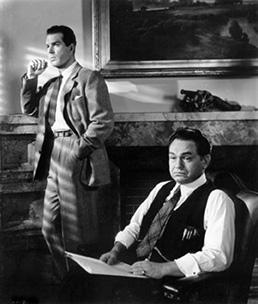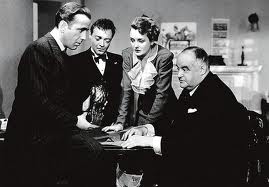There are two cuts of The Big Sleep. The original reveals the identity of the murderer. The other does not. I’ve seen both, but couldn’t tell you who did it. It’s just too complicated. Even during the making of the film, one of the actors asked director Howard Hawks and even he didn’t know. So they called the original novelist Raymond Chandler (co-screenwriter for Double Indemnity). He didn’t remember either–he had to recheck his own book.
There are only a handful a movie mysteries in which the most paramount element is not the resolution. (Another prime example will be mentioned in a future Noir segment). With The Big Sleep, ace private-eye Phillip Marlowe (Humphrey Bogart) navigates through a labyrinth that you hope he never escapes. Marlowe parries off one threat only to fall smack dab into another. By the third act, a bevy of new faces enter the fray. Rather than becoming coherent, the enigma only deepens. During the prelude to the exciting conclusion, Marlowe recounts the events, but it’s like drawing lines from point A to point G without touching any of the other connected points. If you manage to draw five straight connections without overlapping, you’ve done well. Just don’t expect to ever connect them all.
The Big Sleep stands as one of the greatest of film noirs. Any hindrance to its critical and fan accolades is all due to its complicated plot. It requires a large attention span and grander memory to recount the twists and turns. The beauty of The Big Sleep is that each viewing rewards us; we understand a little more with each pass, even if the holes never fill properly. But it never frustrates. I never walk away believing that the gaps are due to the scripts’ imperfections, but rather the limitations of my own sleuthing abilities. As we plug away at the tidbits of each plot element, we eventually get lost somewhere near the end, but enjoy the journey–the moments.
 There’s good ol’ Bogie. Following him has never been so fun. His Marlowe is the kind of guy who can share a drink with a stranger and squeeze a confession out of him before gulping the final sip. He can charm a beautiful women in even less time.
There’s good ol’ Bogie. Following him has never been so fun. His Marlowe is the kind of guy who can share a drink with a stranger and squeeze a confession out of him before gulping the final sip. He can charm a beautiful women in even less time.
The film is one large investigation. Marlowe is hired by a rich, elderly man, Mr. Rutledge, for a blackmail racket. At one point Marlowe pretends to be a snooty book collector to obtain pertinent information from a uptight store clerk. His disguise: he pulls down the brim of his fedora and dons sunglasses; pretending to be a high-society collector. Without any luck, he exits, returns to his commonplace self-assured manner, walks across the street, and charms the clerk from a competing store. Naturally, she’s a knockout and there’s flirtations as Marlowe spies on the shop across the street.
Marlowe is the kind of guy who loves the tease of his womanizing, but always remains fixated on the job first. Unlike Bond, he’s more interested in the case than knocking boots with a complete stranger. You get the sense that he’s happy with ideas of sexual innuendo. He’s sure of himself, straight-as-an-arrow, and invokes the kind of masculinity and persona most men would envy. He even earns the attention of his female cab driver (also a beauty, naturally) during a brief moment as he tails a lead. Before departing, she tells him “If you can use me again sometime, call this number”. Marlowe asks “Day and night?” Her response, “Uh, night’s better. I work during the day.”
Speaking of Bond, there’s a lot to Marlowe that connects him to the famous British spy, who wouldn’t be introduced for another 20 years. For example, when Marlowe is captured and tied down, he observes the efficiency of his imprisonment and cynically mutters “Your boys are taking any chances.” He understands the dangers, but seems more amused than nervous. Marlowe seems to already have an escape plan underway. In the blink of an eye, he charms the pretty ladies, but unlike 007, he’s content with a quick flirt rather chauffeuring them off to a hotel room.
During the film’s opening, Marlowe makes his way through Rutledge’s mansion where he meets his floozy, flirty daughter Carmen (Martha Vickers). She literally throws herself into his arms, but she’s just a kid. Marlowe does become bedazzled by Carmen’s elder, divorcee sister, Vivian (Lauren Bacall). She’s tough, strong and smart enough to keep up. The two ignite a chemistry that the studio hoped to capitalize after their first film, To Have and Have Not (1944, also directed by Hawks and Bacall’s film debut) sizzled on movie screens, mainly due to their dynamic chemistry.
 As the case unravels, Carmes meets Marlowe in his office to offer information. Suspicious, Marlowe asks her why she didn’t go straight to the police. Calling his bluff, Vivian picks up his phone and immediately calls the cops. Marlowe’s convinced. He steals the phone away and has fun with the confused receiver on the other end. The two pretend to be elder folks with misdialed. Their chemistry is playful, infectious, and, with a film like this, dangerous. She might make a suitable mate–assuming she’s not one of the bad guys.
As the case unravels, Carmes meets Marlowe in his office to offer information. Suspicious, Marlowe asks her why she didn’t go straight to the police. Calling his bluff, Vivian picks up his phone and immediately calls the cops. Marlowe’s convinced. He steals the phone away and has fun with the confused receiver on the other end. The two pretend to be elder folks with misdialed. Their chemistry is playful, infectious, and, with a film like this, dangerous. She might make a suitable mate–assuming she’s not one of the bad guys.
During the filming of The Big Sleep, Bogart’s marriage was on the rocks and he and Bacall were already romantically involved. The two married just three months after shooting The Big Sleep. The marketing of the Big Sleep focused on the insatiable sparks between Bogie and Bacall. The film was originally released in 1945 and shown to troops in Europe. However, the studio was not happy with some of the scenes and had them reshot to add more sizzle between the two leads, who were then married at the time.
Although I always favored scenes with Bogart’s as he autonomously prevues the scenes of crime and unleashes his tricks and mouth to unearth the mystery’s layers. Bogie is a more straight shooter in Big Sleep than Falcon. He’s likable because he takes risks for his clients; maintaining a noble confidence reserved for lawyers and shrinks. He risks both reputation and life to protect his clients. For example, he finds Carmen at the scene of a murder. Immediately, he brings her home and never tells the cops or her family where she was. Unlike Sam Spade, Marlowe follows a code of client privilege, rather than aiming to save his own neck.
 At this point, it’s evident that the beauty of the earlier noir has been the majesty of new talkie era: where larger-than-life quips constantly stream from the mouths of larger-than-life movie icons. The players’ retorts are droll and wickedly clever that even the quickest minds would need generally require long gaps to compose such biting quips. But that’s the joy of the movies–we get to bypass the broken sentences and disjointed thoughts and ingest in the poetry as if it were a Shakespearean play. These characters are smart and clever. There is a one wonderful counterattack of words as Marlowe sizes up a man he suspects is up to something. Marlowe says to the man, “Convenient, the door being open when you didn’t have a key, eh? “Yeah, wasn’t it,” he responds. “By the way, how’d you happen to have one?” asks Marlowe. “Is that any of your business” he asks. “I could make it my business,” Marlowe threatens. “I could make your business mine”, he counters. “Oh, you wouldn’t like it. The pay’s too small.”
At this point, it’s evident that the beauty of the earlier noir has been the majesty of new talkie era: where larger-than-life quips constantly stream from the mouths of larger-than-life movie icons. The players’ retorts are droll and wickedly clever that even the quickest minds would need generally require long gaps to compose such biting quips. But that’s the joy of the movies–we get to bypass the broken sentences and disjointed thoughts and ingest in the poetry as if it were a Shakespearean play. These characters are smart and clever. There is a one wonderful counterattack of words as Marlowe sizes up a man he suspects is up to something. Marlowe says to the man, “Convenient, the door being open when you didn’t have a key, eh? “Yeah, wasn’t it,” he responds. “By the way, how’d you happen to have one?” asks Marlowe. “Is that any of your business” he asks. “I could make it my business,” Marlowe threatens. “I could make your business mine”, he counters. “Oh, you wouldn’t like it. The pay’s too small.”
Director Howard Hawks infuses Sleep with all of the moods of established by Wilder in Double Indemnity along with his own platter. Max Steiner’s brooding score subsides while Marlowe excavates the mystery, allow the night to crackle with the eerie sounds of crickets and the nightlife, installing an ominous mood. There’s also the rain, the cracking of the thunder that adds to the sense of danger creeping around each corner.
 Like Maltese Falcon, The Big Sleep keeps the audience watchful shadow over our hero, Marlowe. We know only what he knows. We are given the same opportunity to pick up the pieces and try hard to put them together. By the film’s end, Marlowe seems to grasp more of the plot than we do–or at least seems content with the conclusion when the villain is thwarted and Marlowe is locking eyes with the damsel in distress. I wouldn’t dare reveal more, only to say that the ending purely meshes the tried-and-true love conquers all sentiment without the sappy long-winded kiss–just a knowing exchange of glances that fades out. Romantics can piece together a happy ending while the cynics will question if Bacall was completely innocent in the charade. Either way, this a convoluted journey that is some of the finest film-making Hollywood has bestowed. And Bogie and Bacall still sizzle.
Like Maltese Falcon, The Big Sleep keeps the audience watchful shadow over our hero, Marlowe. We know only what he knows. We are given the same opportunity to pick up the pieces and try hard to put them together. By the film’s end, Marlowe seems to grasp more of the plot than we do–or at least seems content with the conclusion when the villain is thwarted and Marlowe is locking eyes with the damsel in distress. I wouldn’t dare reveal more, only to say that the ending purely meshes the tried-and-true love conquers all sentiment without the sappy long-winded kiss–just a knowing exchange of glances that fades out. Romantics can piece together a happy ending while the cynics will question if Bacall was completely innocent in the charade. Either way, this a convoluted journey that is some of the finest film-making Hollywood has bestowed. And Bogie and Bacall still sizzle.













